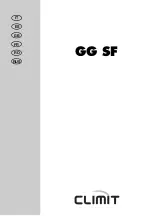
4 Installation
Installation manual
13
D035A1/4AB + D035A4AB
Wall-mounted condensing boiler
3P469346-5N – 2019.11
E
Central heating supply connection, 3/4"
F
Gas inlet connection, 3/4"
G
Safety valve discharg
A
a
B
F
D
E
Valve
Strainer
Tee connection
Double check valve + filling hose
Disconnector
a
External filling group used with models D2TND028A4AB
and D2TND035A4AB. Use a disconnector or a double
check valve according to local regulations.
If the boiler will only be used for central heating, storage tank
connections should be blinded.
Isolation valves and strainers should be used just before the
appliance piping inlet as shown in figure above. Boiler is filled with
external fresh water supply.
Ensure that necessary gaskets are placed.
Note:
Optional Daikin connection kit can be used and it is
recommended to use it.
4.8.2
Guidelines when connecting the gas
piping
This unit is designed to be operated with natural gas or LPG. The
preset gas type and the designated gas inlet pressure are indicated
on the boiler's identification label.
WARNING
Only qualified persons are allowed to connect the gas
piping. The gas inlet pipe diameter must be selected
according to the applicable legislation, standards, and
regulations.
Connect the gas piping according to applicable legislation of the
country of destination and the regulations of the gas supply
company.
Connect the gas supply piping without tension to the gas pipe
connection ("Connection F", see
WARNING
After the gas connection is made, the gas line must be
tested for leakage while the gas line to the boiler is open
(see
"5.3 To check for gas leakage"
In case gas piping is adjacent to the wall and is to be connected to
the gas pipe connection of the boiler with an elbow, enough space
for taking out the condensate trap must be left. This can be done in
two ways:
1
Elbow must be placed crosswise so it will not block the
condensate trap when it is being taken out.
2
Elbow must be placed 200 mm below the gas piping connection
of the boiler.
4.8.3
Guidelines when connecting the water
piping
When connecting the piping to the boiler, observe the following
instructions:
WARNING
Ignoring the rules explained below may result in serious
damages in installation or boiler or cause discomfort of the
user. The manufacturer is not responsible for any damage
that may occur this way.
▪ The installation of the boiler should be in compliance with the
applicable legislation, standards, and regulations.
▪ The materials used in the installation must be in compliance with
the applicable legislation, standards, and regulations.
▪ Heating installation piping material must not allow oxygen diffusion
according to DIN4726.
▪ The central heating/domestic hot water installation should be
flushed and visually inspected. Wastes, dust, rubbers, and metal
pieces generated during the installation and mounting of the boiler
must be removed in order not to cause any damage.
▪ The central heating circuit must be able to withstand a pressure of
at least 6 bar.
▪ Cross connection must be preferred in the radiators longer than
1.5 metres.
▪ The safety valve piping should be connected to a water outlet with
an additional hose or piping. This outlet should not be installed in
places where there is risk of freezing, nor in the rain gutter, it
should not end to dry floor without available drainage to avoid
damaging of floor coating like parquet.
▪ The maximum pressure in the domestic hot water circuit is 10 bar.
Inspect the piping taking this in to consideration. If the water
pressure of the main water supply is excessive, use an
appropriate pressure reducer. Installation must comply with
EN 15502-2-2.
▪ As the condensing boilers generate condensate, the condensate
trap outlet should be connected to an open drain. Piping and
elements of the drain line must be made of acid-resistant material
like plastics. Metals like steel or copper are not allowed.
▪ The system must be air-free to protect the boiler. There are two
automatic air vents on the boiler, one at heat exchanger, the other
on the pump. Ensure air is discharged completely at each water
filling. Bleed the radiators if necessary.
▪ If the boiler will be connected to an old central heating/domestic
hot water installation, then first visually inspect the old installation.
The installation must be in compliance with the capacity of the
boiler and must not prevent the efficient running of it. Dirt in old
system and piping must be flushed, and filters must be inspected.
Summary of Contents for D2CND028A1AB
Page 31: ......














































